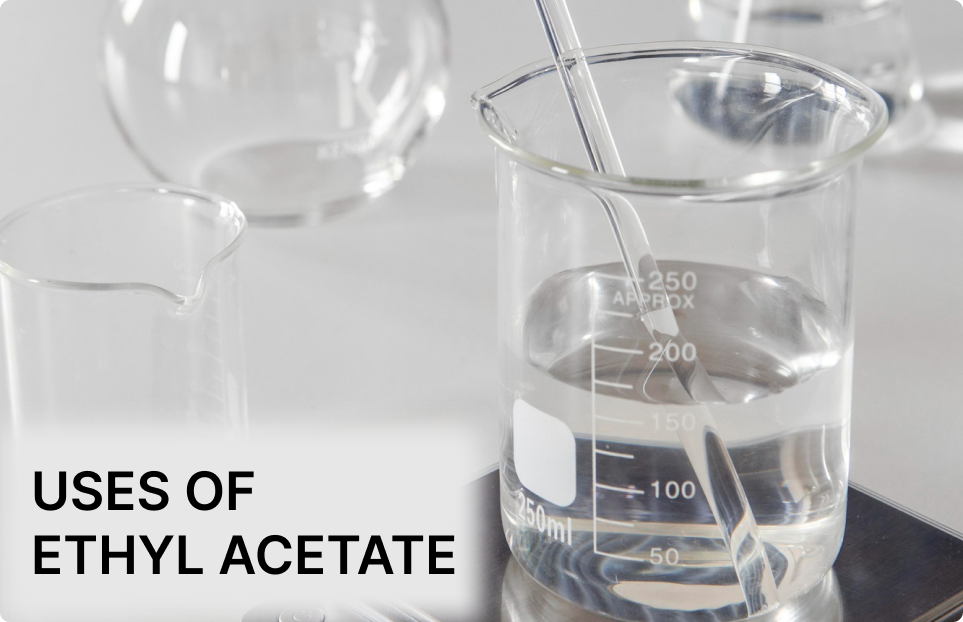
June 27, 2024
Exploring the Many Uses of Ethyl Acetate
Ethyl acetate, often relegated to the back of the shelf next to nail polish remover, boasts a surprisingly diverse range of applications. This colorless liquid, with a pleasant fruity scent, is a hidden hero in numerous industries, playing a crucial role in everyday products and processes.
A Closer Look at Ethyl Acetate
Ethyl acetate is a simple ester, formed by the reaction of ethanol (ethyl alcohol) and acetic acid (vinegar). Its key properties include:
Sweet, fruity odor: This characteristic aroma makes it suitable for use in perfumes and flavorings.
Excellent solvent: Ethyl acetate readily dissolves various substances, making it a valuable tool in numerous applications.
Moderate volatility: It evaporates at a moderate rate, allowing for controlled solvent action.
Relatively low toxicity: Compared to some other solvents, ethyl acetate exhibits lower toxicity, although proper handling precautions are still essential.
Production Processes
Fischer Esterification Reaction
The main industrial method for producing ethyl acetate is the Fischer esterification reaction between ethanol and acetic acid. The reaction is carried out at room temperature and can be accelerated using acid catalysts. The equilibrium can be shifted towards the product by removing water.
A Journey Through Ethyl Acetate’s Applications
Let’s embark on a journey to explore the various applications of ethyl acetate across different sectors:
1. The World of Solvents:
Paints, Varnishes, and Coatings: Ethyl acetate is a versatile solvent used in the formulation of paints, varnishes, and coatings. It effectively dissolves resins, binders, and pigments, ensuring a smooth consistency and proper application of these coatings.
Adhesives: Certain adhesives utilize ethyl acetate as a solvent during their manufacturing process. It helps dissolve adhesive components and achieve the desired viscosity and application characteristics.
Decaffeination: The decaffeination process of coffee and tea sometimes employs ethyl acetate as a selective solvent to remove caffeine from beans or leaves. Due to its relatively low boiling point, it can be easily separated from the decaffeinated product.
2. The Realm of Fragrances and Flavors:
Perfumes and Cosmetics: The pleasant fruity scent of ethyl acetate makes it a valuable ingredient in perfumes and cosmetic products. It acts as a solvent for essential oils and fragrance compounds, helping to disperse and deliver the desired aroma.
Food Flavorings: In controlled quantities, ethyl acetate can be used as a flavoring agent in certain foods. Its fruity notes can enhance the taste of candies, chewing gum, and some beverages. Ethyl acetate is a common ester in wines, contributing to their fruity flavor and aroma.
3. The Laboratory Workhorse:
Chromatography: Ethyl acetate is a common solvent used in various chromatography techniques, a laboratory separation method. It helps separate components of a mixture based on their different interactions with the stationary and mobile phases.
Extraction Processes: In some laboratory procedures, ethyl acetate can be used as an extraction solvent to isolate specific compounds from a mixture.
4. Beyond the Obvious:
Nail Polish Remover and Cleaning Solutions: Perhaps the most familiar use of ethyl acetate is in nail polish remover. Its solvency power effectively removes nail polish without damaging the natural nails. Additionally, it can be found in some cleaning solutions for removing adhesives or residues.
Textile Industry: Ethyl acetate plays a role in some textile cleaning processes, particularly for delicate fabrics. Its ability to dissolve certain stains and finishes while being gentle on fabrics makes it a suitable option.
Electrical Industry: It is mostly used as a Cleaning Agent. Ethyl acetate, especially high-purity grades, is a valuable solvent for photoresists. Photoresists are light-sensitive materials used in creating the circuit patterns on silicon wafers, the foundation of microchips. Ethyl acetate helps dissolve the photoresist components, allowing for even and precise coating onto the wafer surface during a process called spin-coating, Ethyl acetate can also act as a photoresist stripper.
5. A Glimpse into the Future:
Bio-based Ethyl Acetate: Research is ongoing to develop sustainable production methods for ethyl acetate using renewable resources like biomass. This could offer a more environmentally friendly alternative to traditional production from petrochemicals.
Emerging Applications: Ethyl acetate’s properties are being explored for potential use in new applications, such as:
Biofuel additives: Limited research suggests ethyl acetate might have applications in improving the performance of certain biofuels.
Pharmaceutical industry: While further investigation is needed, ethyl acetate might have potential use in specific pharmaceutical processes. Ethyl acetate is used as the mobile phase in High-Performance Liquid Chromatography (HPLC) analysis.
Conclusion: A Versatile Tool for a Diverse World
Ethyl acetate, often underestimated, is a versatile and valuable industrial solvent with a presence in numerous everyday products. From its role in creating paints and fragrances to its use in scientific research, ethyl acetate’s applications are truly diverse. As we move towards a more sustainable future, the development


